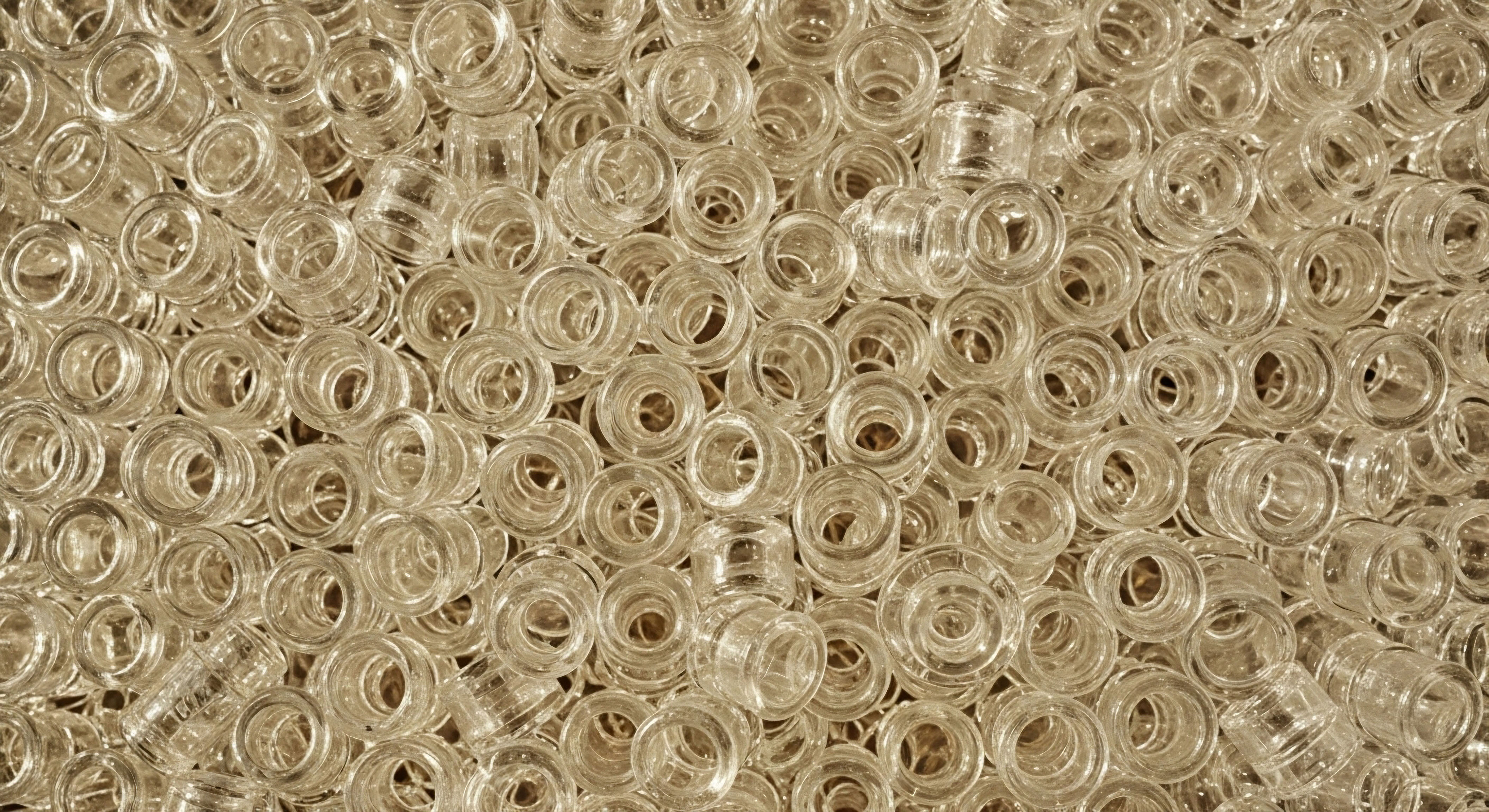

Fundamentals
You may be feeling a shift within your body, a subtle yet persistent change that leaves you questioning your vitality. Perhaps it’s a decline in energy, a noticeable change in your physique despite consistent effort in the gym, or a quiet fading of your libido.
These experiences are common, and they often point toward the intricate world of your endocrine system. Your body communicates through hormones, a complex internal messaging service. Understanding this system is the first step toward reclaiming your sense of self. One of the key regulators in this system is an enzyme called aromatase.
Its primary function is to convert androgens, like testosterone, into estrogens. A certain level of this conversion is essential for male health, supporting bone density and cardiovascular function. However, an elevation in aromatase activity can disrupt the delicate hormonal balance, leading to a decrease in testosterone and a relative increase in estrogen. This imbalance can manifest in the very symptoms you might be experiencing ∞ fatigue, reduced muscle mass, increased body fat, and diminished sexual health.

The Cellular Conductor Aromatase
Aromatase, scientifically known as cytochrome P450 19A1, is not a foreign invader. It is a naturally occurring enzyme found in various tissues throughout the body, including adipose (fat) tissue, the brain, and gonads. Think of it as a cellular conductor, directing the fate of your testosterone molecules.
When this conductor is overactive, it can lead to a state of hyperaromatization, where an excessive amount of testosterone is converted into estradiol, the primary estrogen in men. This process is influenced by several factors, including age, genetics, and, most significantly, lifestyle choices.
Increased body fat, particularly visceral fat around the abdomen, is a major site of aromatase activity. This creates a challenging feedback loop ∞ higher body fat increases aromatase, which in turn can make it more difficult to lose fat and build muscle. Chronic inflammation and elevated insulin levels, often associated with diets high in processed foods and sugars, can also amplify aromatase activity.
Understanding and managing aromatase activity is a critical component of maintaining hormonal health and overall well-being in men.

How Does Diet Influence Aromatase?
Your dietary patterns are a powerful tool for modulating aromatase activity. The foods you consume can either promote or inhibit this enzymatic process. A diet rich in refined carbohydrates and unhealthy fats can contribute to insulin resistance and inflammation, creating an environment where aromatase thrives.
Conversely, a well-structured nutritional plan can help to naturally manage aromatase levels. Certain foods contain phytochemicals, which are plant-based compounds that can act as natural aromatase inhibitors. These compounds can help to preserve your testosterone levels by reducing their conversion to estrogen.
The journey to hormonal optimization begins with a clear understanding of how your daily food choices directly impact your internal biochemistry. By making conscious dietary modifications, you can begin to influence your hormonal landscape and address the root causes of your symptoms.

Key Dietary Considerations for Aromatase Modulation
- Cruciferous Vegetables ∞ Broccoli, cauliflower, cabbage, and Brussels sprouts contain a compound called indole-3-carbinol (I3C), which is converted to diindolylmethane (DIM) in the body. DIM has been shown to modulate estrogen metabolism.
- White Button Mushrooms ∞ These common mushrooms contain phytochemicals that have been studied for their potential to inhibit aromatase activity.
- Green Tea ∞ The catechins in green tea, particularly epigallocatechin gallate (EGCG), are known for their antioxidant properties and may also play a role in aromatase inhibition.
- Citrus Fruits ∞ Fruits like grapefruit and oranges contain flavonoids, such as naringenin, which have been investigated for their effects on aromatase.


Intermediate
Moving beyond the foundational understanding of aromatase, we can now examine the specific dietary strategies that can be employed to modulate its activity. A targeted nutritional approach can be a cornerstone of a comprehensive plan for hormonal optimization. This involves a detailed look at macronutrient ratios, micronutrient status, and the inclusion of specific functional foods.
The goal is to create an internal environment that supports healthy testosterone levels while managing the conversion to estrogen. This is not about restrictive dieting, but rather about a strategic and sustainable way of eating that aligns with your physiological needs.

Macronutrients and Their Impact on the Endocrine System
The balance of proteins, fats, and carbohydrates in your diet has a profound effect on your hormonal milieu. Each macronutrient plays a distinct role in influencing testosterone production and aromatase activity. A one-size-fits-all approach is rarely effective; the optimal ratio will depend on your individual metabolism, activity level, and health goals. However, certain principles can guide your nutritional choices.

Fats a Double-Edged Sword
Dietary fats are essential for hormone production, as cholesterol is the precursor to all steroid hormones, including testosterone. However, the type of fat consumed is critical. Diets high in saturated and trans fats, often found in processed foods and fatty meats, have been associated with increased inflammation and potentially higher aromatase activity.
In contrast, monounsaturated fats (found in avocados, olive oil, and nuts) and polyunsaturated fats, particularly omega-3 fatty acids (found in fatty fish, flaxseeds, and walnuts), have anti-inflammatory properties and may support a healthier hormonal profile. A diet that emphasizes these healthy fats can provide the necessary building blocks for testosterone production without promoting the conditions that favor its conversion to estrogen.
A strategic approach to nutrition, focusing on specific food groups and micronutrients, can be a powerful tool for managing aromatase activity and supporting hormonal balance.

The Role of Protein and Carbohydrates
Adequate protein intake is crucial for maintaining muscle mass, which is important for metabolic health and can help to reduce overall body fat. Some studies suggest that diets with a higher protein-to-carbohydrate ratio may be beneficial for testosterone levels.
However, extremely low-carbohydrate diets can sometimes lead to an increase in cortisol, a stress hormone that can negatively impact testosterone. The key is to choose high-quality, complex carbohydrates from sources like vegetables, fruits, and whole grains, while limiting refined sugars and processed grains that can spike insulin levels and promote inflammation. By carefully managing your carbohydrate intake, you can support stable energy levels and a more favorable hormonal environment.

Micronutrients the Unsung Heroes of Hormonal Health
While macronutrients provide the bulk of our dietary intake, micronutrients play a vital role in regulating enzymatic processes, including aromatase activity. Deficiencies in certain vitamins and minerals can impair testosterone production and contribute to hormonal imbalances. Ensuring adequate intake of these key micronutrients is an essential part of any nutritional strategy for hormonal optimization.
| Micronutrient | Function in Hormonal Health | Dietary Sources |
|---|---|---|
| Zinc | A crucial mineral for testosterone production and a known aromatase inhibitor. | Oysters, red meat, poultry, beans, nuts, pumpkin seeds. |
| Magnesium | Associated with increased free and total testosterone levels in both sedentary individuals and athletes. | Leafy green vegetables, nuts, seeds, dark chocolate, avocados. |
| Vitamin D | Functions as a steroid hormone in the body and has been linked to higher testosterone levels. | Fatty fish (salmon, mackerel), fortified milk and cereals, sunlight exposure. |
| Boron | A trace mineral that has been shown in some studies to increase free testosterone and decrease estradiol levels. | Raisins, almonds, prunes, chickpeas. |

Phytochemicals Natural Aromatase Inhibitors
Beyond vitamins and minerals, certain plant-based compounds, known as phytochemicals, have demonstrated the ability to inhibit aromatase activity. These compounds are found in a variety of fruits, vegetables, and herbs and can be a valuable addition to a hormone-supportive diet. By incorporating these foods into your daily meals, you can leverage their natural properties to help maintain a healthy testosterone-to-estrogen ratio.
- Flavonoids ∞ This large class of phytochemicals includes compounds like chrysin (found in passionflower and honey), apigenin (found in parsley, celery, and chamomile), and naringenin (found in grapefruit). These flavonoids have been studied for their potential to block the aromatase enzyme.
- Lignans ∞ Found in high concentrations in flaxseeds, lignans are converted by gut bacteria into enterolignans, which can modulate estrogen metabolism.
- Resveratrol ∞ This compound, found in the skin of red grapes, berries, and peanuts, has been shown to have aromatase-inhibiting properties in some studies.


Academic
An in-depth examination of the interplay between dietary patterns and aromatase activity requires a journey into the molecular mechanisms that govern this enzymatic process. The regulation of aromatase is a complex affair, involving genetic expression, post-translational modifications, and the influence of various signaling pathways.
Dietary components do not simply interact with the enzyme in a vacuum; they influence the very cellular machinery that produces and activates it. This section will explore the intricate biochemical and physiological pathways through which nutrition exerts its effects on aromatase, providing a more granular understanding of this critical aspect of male endocrine health.

Transcriptional Regulation of the Aromatase Gene (CYP19A1)
The aromatase enzyme is encoded by the CYP19A1 gene. The expression of this gene is a key control point for aromatase activity and is regulated in a tissue-specific manner through the use of alternative promoters. In adipose tissue, the primary site of aromatase expression in men, the promoter I.4 is particularly important. The activity of this promoter is influenced by various signaling molecules, many of which are directly or indirectly affected by diet.

The Role of Inflammatory Cytokines and Prostaglandin E2
Chronic low-grade inflammation, often associated with obesity and diets high in processed foods, is a potent stimulator of aromatase expression in adipose tissue. Inflammatory cytokines, such as tumor necrosis factor-alpha (TNF-α) and interleukin-6 (IL-6), can upregulate the expression of cyclooxygenase-2 (COX-2). COX-2, in turn, leads to the production of prostaglandin E2 (PGE2).
PGE2 is a powerful inducer of the aromatase promoter I.4, leading to increased aromatase synthesis. This creates a feed-forward loop where inflammation drives aromatase expression, and the resulting increase in local estrogen production can further promote inflammation. Dietary patterns rich in anti-inflammatory compounds, such as omega-3 fatty acids and polyphenols, can help to break this cycle by reducing the production of inflammatory cytokines and inhibiting COX-2 activity.
The molecular dialogue between dietary components and the cellular mechanisms controlling aromatase expression is a key determinant of hormonal balance in men.

Direct Inhibition of the Aromatase Enzyme
In addition to influencing gene expression, certain dietary compounds can directly interact with the aromatase enzyme, inhibiting its catalytic activity. These natural aromatase inhibitors often belong to the flavonoid and non-flavonoid polyphenol families. Their mechanism of action typically involves binding to the active site of the enzyme, preventing it from converting androgens to estrogens. The effectiveness of these compounds can vary widely, and their bioavailability and metabolism in the human body are important factors to consider.
| Compound | Proposed Mechanism of Action | Key Dietary Sources |
|---|---|---|
| Quercetin | A flavonoid that acts as a competitive inhibitor of aromatase, binding to the enzyme’s active site. | Onions, apples, berries, capers. |
| Apigenin | A non-competitive inhibitor that binds to a site other than the active site, altering the enzyme’s conformation and reducing its activity. | Parsley, celery, chamomile tea. |
| EGCG (from Green Tea) | Exhibits mixed-type inhibition, suggesting it can bind to both the free enzyme and the enzyme-substrate complex. | Green tea. |
| Resveratrol | A non-flavonoid polyphenol that has been shown to reduce aromatase expression and activity in various cell types. | Red grapes, peanuts, berries. |

The Influence of Insulin and the Insulin-Like Growth Factor (IGF-1) Axis
The insulin/IGF-1 signaling pathway plays a crucial role in cellular growth and metabolism, and it also has a significant impact on aromatase activity. Hyperinsulinemia, a condition of chronically elevated insulin levels often resulting from a diet high in refined carbohydrates, can promote aromatase expression.
Insulin and IGF-1 can activate signaling cascades, such as the phosphatidylinositol 3-kinase (PI3K)/Akt pathway, which can lead to the phosphorylation and activation of transcription factors that promote CYP19A1 gene expression. Therefore, dietary strategies aimed at improving insulin sensitivity, such as reducing the intake of high-glycemic carbohydrates and increasing fiber consumption, can be an effective way to downregulate aromatase activity.
This highlights the interconnectedness of metabolic and endocrine health, where dietary choices that improve metabolic function can have a direct and positive impact on hormonal balance.

What Are the Implications for Testosterone Replacement Therapy?
For men undergoing Testosterone Replacement Therapy (TRT), understanding the role of diet in aromatase modulation is particularly important. Exogenous testosterone administration can sometimes lead to an increase in aromatase activity, resulting in elevated estrogen levels and potential side effects.
While aromatase inhibitors like anastrozole are often prescribed alongside TRT to manage this conversion, dietary and lifestyle modifications can provide a complementary approach. By adopting a diet that naturally inhibits aromatase and reduces inflammation, individuals on TRT may be able to achieve their therapeutic goals with a lower dose of medication, thereby minimizing potential side effects. This integrated approach, combining medical treatment with targeted nutritional strategies, represents a more holistic and personalized model of care for men with low testosterone.

References
- de Ronde, W. & de Jong, F. H. (2011). Aromatase inhibitors in men ∞ effects and therapeutic options. Reproductive Biology and Endocrinology, 9(1), 93.
- Cohen, P. G. (2011). The role of aromatase in the pathogenesis of obesity-related hypogonadism. Medical Hypotheses, 77(2), 274-278.
- Hämäläinen, E. Adlercreutz, H. Puska, P. & Pietinen, P. (1984). Diet and serum sex hormones in healthy men. Journal of Steroid Biochemistry, 20(1), 459-464.
- Williams, G. (2012). Aromatase up-regulation, insulin and raised intracellular oestrogens in men, induce adiposity, metabolic syndrome and prostate disease, via aberrant ER-α and GPER signalling. Molecular and Cellular Endocrinology, 351(2), 269-278.
- Mínguez-Alarcón, L. Chavarro, J. E. Mendiola, J. Roca, M. Tanrikut, C. Vioque, J. & Torres-Cantero, A. M. (2017). Fatty acid intake in relation to reproductive hormones and testicular volume among young healthy men. Asian Journal of Andrology, 19(2), 184.
- Pilz, S. Frisch, S. Koertke, H. Kuhn, J. Dreier, J. Obermayer-Pietsch, B. & Zittermann, A. (2011). Effect of vitamin D supplementation on testosterone levels in men. Hormone and Metabolic Research, 43(03), 223-225.
- Cinar, V. Polat, Y. Baltaci, A. K. & Mogulkoc, R. (2011). Effects of magnesium supplementation on testosterone levels of athletes and sedentary subjects at rest and after exhaustion. Biological Trace Element Research, 140(1), 18-23.
- Balasubramanian, A. Thirumavalavan, N. Srivatsav, A. Yu, J. Lipshultz, L. I. & Pastuszak, A. W. (2019). Testosterone and the heart. Urologic Clinics, 46(3), 285-293.
- Grishina, O. & Adlercreutz, H. (2007). A review of the role of dietary lignans in the reduction of the risk of prostate cancer. Journal of Steroid Biochemistry and Molecular Biology, 103(3-5), 344-350.
- Wang, Y. Lee, Y. M. & Yeung, S. Y. (2011). A study of the potential aromatase inhibitory action of the isoflavone, biochanin A. Journal of Enzyme Inhibition and Medicinal Chemistry, 26(5), 724-730.

Reflection
The information presented here offers a detailed map of the biochemical pathways that connect your plate to your hormonal health. This knowledge is a powerful tool, a starting point for a more conscious and proactive approach to your well-being.
The journey to hormonal optimization is a personal one, a process of self-discovery that goes beyond simply following a set of rules. It involves listening to your body, observing the changes that occur with different dietary strategies, and understanding that your unique physiology will respond in its own way.
The path forward is one of partnership ∞ with your body and with knowledgeable healthcare providers who can guide you in interpreting your body’s signals and creating a personalized plan. The ultimate goal is not just to manage a single enzyme or hormone, but to cultivate a state of vitality and resilience that allows you to function at your full potential.



